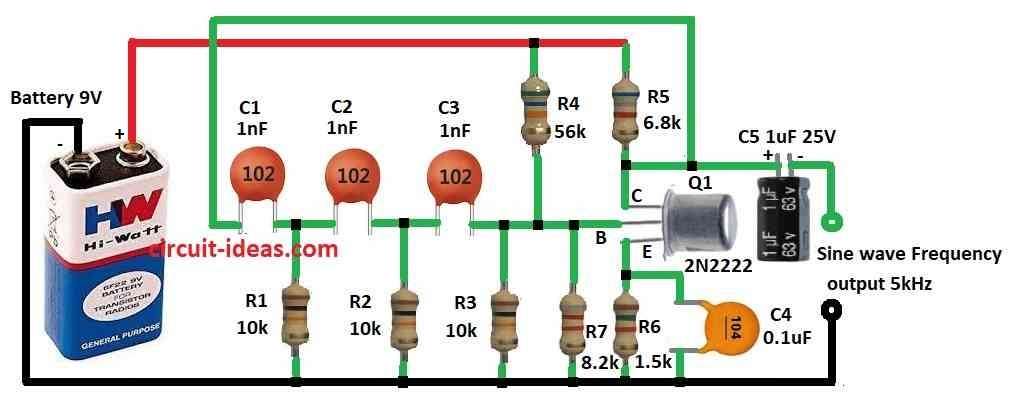Simple Phase Shift Oscillator Circuit using a Single Transistor is like a special electric circuits.
They make electric go up and down like water wave.
These waves can be soft or hard and also look like curved.
How fast wave go up and down are controlled by the circuit control
There are many types of oscillator circuits.
One kind is called RC oscillator which need special part called RC network to make smooth and curved waves.
This RC network send signal back to itself and help keep the wave going.
Circuit Working:

Parts List:
| Type | Description | Quantity |
|---|---|---|
| Resistors (All resistors are 1/4 watt unless specified) | 10k | 3 |
| 56k | 1 | |
| 6.8k | 1 | |
| 8.2k | 1 | |
| 1.5k | 1 | |
| Capacitors | Ceramic 1nF | 3 |
| Ceramic 0.1µF | 1 | |
| Electrolytic 1µF 25V | 1 | |
| Semiconductors | Transistor 2N2222 | 1 |
| Battery 9V | 1 |
This circuit is used in resistor and capacitor to make network.
This network send back signal to give needed phase shift.
RC oscillator are used in many things to keep frequency very stable and very good.
This oscillator make wave in needed frequency using NPN transistor 2N2222 and other small parts.
One full diagram show how it work and this article tell basic working and where to use RC oscillator.
NPN transistor 2N2222 work like amplifier in this small circuit which gets feedback from RC network.
Output come from transistor collector side where one capacitor is connected.
When we use 9V DC power wave happen because voltage keep changing and base current changes because of noise in transistor.
Transistor make these changes bigger.
RC network have 3 parts and each part give 60° phase shift.
Together feedback gives 180° phase shift.
Transistor also give 180° more so total is 360° and this make positive feedback.
Output is smooth wave which always continues.
Formulas:
This formula show how resistor and capacitor RC circuit work and how frequency says in two ways like normal frequency (f) and round frequency (ω):
ω = 2 * π * ƒ = 1.732 / RC
where:
- When wave go in circle way we call that angular frequency (ω).
- When wave repeat again and again each second then we call that normal frequency (f) in hertz Hz.
- The number 2π (pi) help to change f into ω:
ω = 2π * f
When resistor R connect in line with capacitor C that make simple RC circuit.
This number 1.732 in formula show how RC circuit time and frequency connect.
Formula say like this:
If we use ω = 2π * f we just multiply by 2π to change f into ω.
Also formula 1.732 / RC show almost same as time constant in RC circuit.
How to Build:
To build a Simple Phase Shift Oscillator Circuit using a Single Transistor following are the steps required for connections
Set Up Transistor:
- Put NPN transistor 2N2222 on PCB.
- Check which leg is emitter, base and collector.
Place Capacitors and Resistors:
- Put capacitors C1, C2 and C3 between transistors base and collector.
- Then put resistors R1, R2 and R3 between transistor base and where capacitors join.
Connect Power:
- Connect +9V power to collector leg of transistor.
- Connect emitter leg to ground.
R1 is Base Resistor:
- Connect resistor R1 between join point of C1 and R2 to base of transistor.
Feedback Network (R2, C2, R3, C3):
- Connect R2 and C2 in line series between base and where C1 and R2 meet.
- Also connect R3 and C3 in line from transistor base to join point of R2 and C2.
Output Connection:
- Take output from join point of R3 and C3.
Test Circuit:
- Use 9V DC battery to power.
- If we have oscilloscope use it to see wave output.
- Change resistor or capacitor values to make different frequency.
Fix Problems:
- Be sure all wires and pins are correct.
- Check if resistor and capacitor values match the frequency we want.
- Also see how time constant (τ) and frequency are working together in RC circuit.
Conclusion:
In this Simple Phase Shift Oscillator Circuit using a Single Transistor we should be careful with parts and look at datasheets for full information.
To get different wave frequencies change resistor or capacitor.
We can also test and try to see how it changes the wave.
Leave a Reply